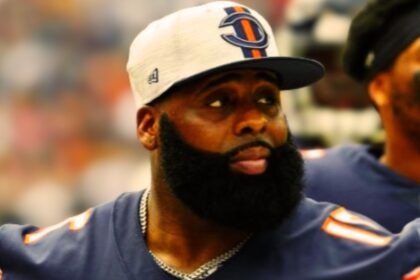“Rest In Peace: The Legacy of the ‘Cha Cha Slide’ Creator”
The world mourns the loss of a musical icon as DJ Casper,…
“Former NFL Player Blake Proehl Exits American Idol, Charlotte’s Hopes Dashed”
Blake Proehl's journey from Charlotte native to American Idol contestant has been…
Jason Peters: The Ageless Wonder of the NFL
In the world of professional football, longevity is a rare feat. But…
“Rest In Peace AJ Simon: A Tribute to a Rising Star”
The football world was shaken by the tragic news of Amitral "AJ"…
“Aidan O’Connell: Stepping Up to the Challenge of Raiders’ Quarterback Competition”
As the Las Vegas Raiders gear up for the upcoming NFL season,…
“Tragic Loss: California Woman Falls to Her Death While Hiking in Sedona with Family”
In a heartbreaking incident, 40-year-old Zaynab Joseph lost her life after falling…
“Browns’ Cornerback Greg Newsome: Focused Amidst Trade Rumors”
Greg Newsome II, the Cleveland Browns' former first-round pick, finds himself amidst…
“Rest In Peace Samantha Davis: A Legacy of Love and Advocacy”
Samantha Davis, co-founder of the dwarfism charity Little People UK and beloved…
“Colts Secure Defensive Anchor DeForest Buckner with Lucrative Contract Extension”
By extending the contract of standout defensive tackle DeForest Buckner, the Indianapolis…
“Vikings TE T.J. Hockenson Calls for Increased Protection for Offensive Players Against Low Hits”
Minnesota Vikings tight end T.J. Hockenson has sparked a conversation about player…
“Eagles Make Bold Move, Secure DeVonta Smith with Lucrative Three-Year, $75 Million Extension”
In a decisive move, the Philadelphia Eagles have solidified their commitment to…
“Rams LB Ernest Jones Embraces Challenge Without Aaron Donald, Ready to Lead Defense”
Los Angeles Rams linebacker Ernest Jones is gearing up for a monumental…
“Raiders’ Maxx Crosby Returns to Full Health, Ready to Dominate in 2024”
Las Vegas Raiders' standout edge rusher Maxx Crosby is gearing up for…
“UFC Manager Drops Bombshell: Pereira’s Shocking UFC 301 Withdrawal & Aspinall Showdown in Limbo”
In the high-stakes world of mixed martial arts, where every bout represents…
Holloway’s Shocking Revelation: McGregor Rematch Dubbed ‘The Ultimate Showdown’
Max Holloway, the pride of Hawaii, has emerged victorious once again, claiming…
“UFC Vegas 92: Explosive Matchups & Shocking Showdowns Revealed!”
The Main Event The stage is set, and the anticipation is palpable…
“Shocking Twist: Max Holloway’s Controversial Move Stuns UFC 300 in Epic Knockout”
In the world of mixed martial arts, certain moments transcend the sport,…
“Rock Legend’s Rant: Inside John Mellencamp’s Abrupt Concert Exit”
Frustration Boils Over as Iconic Singer Clashes with Audience
“Hip-Hop Icon DJ Mister Cee’s Cause of Passing Unveiled: Diabetes Claims a Legend”
The Hip-Hop community continues to grieve the loss of the esteemed DJ…
Shocking: Student Assaults Teacher in Profanity-Filled Classroom Rampage
A Startling Incident Unfolds In the halls of Parkland High School in…
“Browns Legends Bid Farewell: Rashard Higgins and Christian Kirksey Reflect on NFL Journeys”
In a poignant moment at the Browns Cross Country Mortgage Campus, Rashard…
“UFC Stars’ Wild Side: Merab Dvalishvili’s Heroic Blunder and Alexander Volkanovski’s Construction Comedy”
Saving Sean O’Malley from "Fire"! In the adrenaline-fueled world of the UFC,…
“Lions QB Jared Goff Expresses Desire for Long-Term Stay in Detroit Amid Contract Talks”
Jared Goff's future with the Detroit Lions hangs in the balance as…
“Jaguars Bolster Roster with Australian Tight End Patrick Murtagh”
The Jacksonville Jaguars have added a unique talent to their roster in…
Inside the Strategic Silence: Cowboys EVP Stephen Jones Reveals Offseason Blueprint
Among the major areas of the NFL's free agency, the Dallas Cowboys,…
Rampant Highway Robberies: South American Gangs Terrorize Los Angeles Jewelers
A South American criminal gang is rampaging the streets of Los Angeles…
Unveiling O.J. Simpson’s Final Moments: Lawyer Recounts ‘Chilling’ Beer-Drinking Days Before Cancer Claimed Him
O.J. Simpson’s Final Days: A Look into the Controversial Figure's Last Moments!
Universal Studios Hollywood Celebrates 60th Anniversary of Studio Tour with Iconic Changes
Universal Studios Hollywood is embarking on a celebratory tour to celebrate 60…
From Undrafted to NFL Star: Adam Thielen’s Inspiring Journey and Draft Day Insights
Adam Thielen's remarkable journey from undrafted college player to NFL superstar serves…
Brennan Elliot’s Wife, Camilla Row Elliot, Battles Recurring Stomach Cancer: A Tale of Courage and Resilience
The story of Camilla Row Elliot, wife of renowned actor Brennan Elliot,…
The Caitlin Clark WNBA Salary Debate: Exploring the Complexities Beyond the Numbers
Caitlin Clark's meteoric rise from collegiate basketball sensation to WNBA draft pick…
Aljamain Sterling Speaks Out on Being Overlooked After UFC 300 Victory: “It Definitely Sucked!”
Aljamain Sterling, former UFC bantamweight champion, has broken his silence on his…
Remembering Kyle Marisa Roth: TikTok’s Controversial Voice Silenced at 36
The sudden departure of Kyle Marisa Roth, a luminary within the TikTok…
Legal Showdown: Channing Tatum and Jenna Dewan Face Off in Divorce Deposition Drama
In the ongoing saga of Channing Tatum and Jenna Dewan's divorce, a…
“Chris Paul is not RETIRING,” Declares NBA Return: The 20th Season Saga Begins!
Chris Paul's NBA Journey Continues: Defying Odds for a 20th Season!
‘I Need My Top to Stay On!’ – Katy Perry’s Near Wardrobe Malfunction Sends Shockwaves on American Idol!
American Idol’s Heart-Stopping Moment: Katy Perry’s Top Mishap Leaves Everyone Breathless!
Royal Announcement: Crown Prince Hussein and Princess Rajwa Expecting Their First Child
Jordan's Crown Prince Hussein and Princess Rajwa are anticipating the arrival of…
”R.I.P”: ‘Warwick Davis’ Wife’s Tragic Passing at 53 Leaves Fans Stunned’
In a heartfelt tribute that resonated with millions around the globe, Warwick…
“R.I.P”: ‘Shocking Death Before Draft Stuns NFL Community’
Former Albany star Amitral 'AJ' Simon, a promising NFL prospect, has shockingly…
Ilia Topuria Eyes Showdown with Max Holloway at The Sphere
Featherweight Champion Ready to Put 'BMF' Title on the Line In a…
Mike Perry Expresses Confusion Over Darren Till’s Rejection of $2 Million Bare-Knuckle Fight Offer
In the ever-evolving landscape of combat sports, matchups often tantalize fans with…
“Miami Mayhem: Diaz vs. Masvidal Press Conference Sparks Controversy”
Miami Set to Ignite with Press Conference Frenzy As the summer heat…
“UFC 303 Shockers: Surprise Additions to Conor McGregor vs. Michael Chandler Card!”
UFC 303, the culmination of International Fight Week 2024, promises to be…
“UFC’s Shocking Return: Louisville’s Controversial Fight Night Revealed!”
Louisville Set to Host Thrilling Fight Night The rumble of anticipation is…
“Breaking: Trevor Bauer Accuser Charged with Fraud After Pregnancy Claims”
The Unfolding Drama The world of Major League Baseball is no stranger…
“Unveiling Secrets: Shocking Revelations from Diaz vs. Masvidal NYC Press Conference”
Nate Diaz and Jorge Masvidal, two titans of combat sports, are set…
“Tsarukyan’s Shocking UFC 302 Snub: Inside His Controversial Decision”
Arman Tsarukyan's Strategic Decision Arman Tsarukyan, the rising star in the UFC…
“Emotional Moments”: The Undertaker Unveils Roman Reigns’ WrestleMania 40 Backstage Saga
WrestleMania 40: The Untold Emotions of Roman Reigns Revealed by the Undertaker!
“It was fun as hell watching you up there” – Brotherly Bond: Travis Kelce’s Proud Moment at WrestleMania
From Gridiron to Ring: Jason Kelce's WrestleMania Revelation!
Wilder vs. Zhang: A Career’s Crossroad – Will the ‘Bronze Bomber’ Survive?
The Final Round: Wilder's Last Stand Against Zhang in Saudi Arabia!



















































